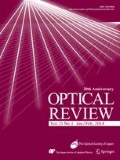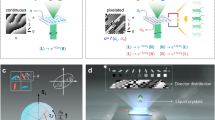Abstract
The optical response of polarization sensitive materials is studied on the basis of a model in which the materials consist of rod molecules that are oriented in random directions. The photoinduced change of the dielectric tensor is expressed as a function of the electric field in a general form. Using this expression, we derive the vectorial coupled wave equations in volume polarization holograms. We discuss the basic properties of polarization holograms.
Similar content being viewed by others
References
L. Nikolova and P. S. Ramanujam: Polarization Holography (Cambridge University Press, Cambridge, U.K., 2009).
L. Nikolova and T. Todorov: Opt. Acta 31 (1984) 579.
T. Todorov, L. Nikolova, and N. Tomova: Appl. Opt. 23 (1984) 4309.
T. Todorov, L. Nikolova, and N. Tomova: Appl. Opt. 23 (1984) 4588.
T. Todorov, L. Nikolova, K. Stoyanova, and N. Tomova: Appl. Opt. 24 (1985) 785.
J. J. Couture: Appl. Opt. 30 (1991) 2858.
S. S. Petrova: Tech. Phys. 46 (2001) 351.
L. Nikolova, K. Stoyanov, T. Todorov, and V. Tatanenko: Opt. Commun. 64 (1987) 75.
V. I. Tarasashvili and A. L. Purtseladze: Opt. Spectrosc. 103 (2007) 1003.
D. Barada, K. Tamura, T. Fukuda, M. Itoh, and T. Yatagai: Opt. Lett. 33 (2008) 3007.
D. Barada, K. Tamura, T. Fukuda, and T. Yatagai: Jpn. J. Appl. Phys. 48 (2009) 09LE02.
D. Barada, Y. Kawagoe, K. Tamura, T. Fukuda, and T. Yatagai: Jpn. J. Appl. Phys. 49 (2010) 01AD02.
Sh. D. Kakichashvili: Opt. Spectrosc. 33 (1972) 324.
Sh. D. Kakichashvili: Sov. J. Quantum Electron. 4 (1974) 795.
L. Nikolova, T. Todorov, M. Ivanov, F. Andruzzi, S. Hvilsted, and P. S. Ramanujam: Appl. Phys. 35 (1996) 3835.
T. Huang and K. H. Wagner: J. Opt. Soc. Am. A 10 (1993) 306.
T. Huang and K. H. Wagner: IEEE J. Quantum Electron. 31 (1995) 372.
H. Ono, M. Nakamura, A. Emoto, and N. Kawatsuki: Jpn. J. Appl. Phys. 49 (2010) 032502.
H. Kogelnik: Bell Syst. Tech. J. 48 (1969) 2909.
H. C. Chen: Theory of Electromagnetic Waves-A Coordinate-Free Approach (MacGraw-Hill, New York, 1985) Chap. 1.
P. Yeh: Introduction to Photorefractive Nonlinear Optics (Wiley, New York, 1993).
L. Nikolova and P. S. Ramanujam: Polarization Holography (Cambridge University Press, Cambridge, U.K., 2009) p. 49.
Author information
Authors and Affiliations
Corresponding author
Rights and permissions
About this article
Cite this article
Kuroda, K., Matsuhashi, Y., Fujimura, R. et al. Theory of polarization holography. OPT REV 18, 374–382 (2011). https://doi.org/10.1007/s10043-011-0072-5
Received:
Accepted:
Published:
Issue Date:
DOI: https://doi.org/10.1007/s10043-011-0072-5




